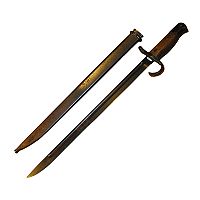- Jūkendō
-
Jūkendō (銃剣道) 
Japanese Type 30 bayonet (1894–1945)Focus Weaponry (Bayonet) Hardness Competitive Country of origin Japan Creator No single creator Parenthood Historical Olympic sport No Jūkendō (銃剣道) is the Japanese martial art of bayonet fighting,[1][2][3][4] and has been likened to kendo (but with bayonets instead of swords).[5] Jukendo techniques are based on sojutsu (spear fighting)[6] or bayonet techniques from the 17th century, when firearms were introduced to Japan.[7]
During the Meiji period, Japanese bayonet fighting techniques were consolidated into a system named jukenjitsu,[7] and taught at the Toyama military academy in Tokyo.[7] Morihei Ueshiba, founder of aikido, trained in jukenjitsu and incorporated some of that art into his own art.[8] Following World War II, the practice of jukenjitsu was banned by the Allies, but it later returned in the modern form of jukendo.[7] The Japan Amateur Jukendo Federation was established in 1952.[9] The All Japan Jukendo Federation was established in April 1956.[10]
Modern jūkendō uses a mokujū, a wooden replica of a rifle with an attached and blunted bayonet at the end, in place of an actual rifle.[5] The art is practised by both Japanese military personnel and civilians.[7] Training incorporates kata (patterns), two-person drills, and competitive matches using mokujū and protective armor.[7] The three main target areas are the heart, throat, and lower left side of the opponent.[7]
See also
References
- ^ Stevens, J. (1985): "The Founder, Ueshiba Morihei." In R. Strozzi-Heckler (Ed.): Aikido and the new warrior (pp. 5–22). Berkeley, CA: North Atlantic. (ISBN 978-0-9381-9051-6)
- ^ Mather, J. (1990): "A Sensei's story: Karate's Takayuki Kubota." Black Belt, 28(6):40–44.
- ^ Steele, D. E. (1991): "Training to fight Saddam's army: US troops prepared for hand-to-hand combat against Iraqis." Black Belt, 29(5):33–36.
- ^ Lowry, D. (2009): The Karate way: Discovering the spirit of practice (p. 76). Boston, MA: Shambhala. (ISBN 978-1-5903-0647-5)
- ^ a b Clayton, B. D., Horwitz, R., & Pollard, E. (2004): Shotokan's secret: The hidden truth behind Karate's fighting origins (p. 148). Black Belt Books. (ISBN 978-0-8975-0144-6)
- ^ Tanaka, F. (2003): Samurai fighting arts: The spirit and the practice (p. 222). Tokyo: Kodansha International. (ISBN 978-4-7700-2898-3)
- ^ a b c d e f g Fighting Arts: Jukendo (c. 2008). Retrieved on February 28, 2010.
- ^ de Jong, H. (c. 2007): Aikido Retrieved on February 28, 2010.
- ^ Wagner, E. A. (1989): Sport in Asia and Africa: A comparative handbook (p. 60). New York: Greenwood. (ISBN 978-0-3132-5767-4)
- ^ All Japan Jukendo Federation (Japanese). Retrieved on February 28, 2010.
External links
- All Japan Jukendo Federation (Japanese)
Martial arts Regional origin Unarmed Weapons Training Grappling Folk wrestling · Brazilian Jiu-Jitsu · Catch Wrestling · Judo · Lucha Libre · Shoot wrestling · Greco-Roman wrestling · Freestyle wrestling · JujutsuFull contact sports Bare-knuckle boxing · Boxing · Full contact karate · Kickboxing · Mixed martial arts · Muay Thai · Sanshou · Shooto · Sambo · TaekwondoSelf-defense/Combatives Entertainment Categories:
Wikimedia Foundation. 2010.
